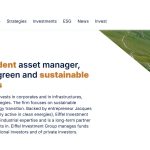How I see it: By Matthew Sekol

Key Takeaways:
- Recent events like the Maui wildfires emphasize the urgency of swift, individual and collective action to address material ESG risks, underlining the need for quality governance and accountability.
- Energy and utility companies play a vital role in combating environmental challenges, including decarbonization and wildfire prevention.
- Corporate leaders must proactively respond to safeguard against potential public damage, aligning ESG initiatives with social responsibilities, and satisfying stakeholder and investor demands.
As a Gen-Xer, I grew up with Smokey Bear telling me, “Only you can prevent forest fires.” Living in rural PA, there is still a working sign in front of the local volunteer fire station with his image, letting us know about today’s wildfire probability.
Over the years, those kids who grew up with Smokey now work at companies that are the custodians of our environmental resources. Specifically, energy and utility companies which can directly impact issues ranging from decarbonization of our hardest to abates industries, the flow of reliable energy to critical services, and the prevention of wildfires caused by their equipment.
It is too early to know the cause of the Maui wildfires, but we do know that Hawaiian Electric Company identified the serious risk of wildfires in 2019, filed a plan with the state’s Public Utility Commission in 2022, where that plan has sat through comments over the past year. In its filed docket for the plan, the company stated they would still proceed with certain adaptation measures due to the severity of the wildfire risk. Yet, in the WSJ, the investments made are reported to be only $245,000 in this effort.
For an energy company, wildfire risk represents an Environmental risk with Social consequences that can be solved with quality Governance and action (and maybe a little Technology).
This is a tough one to analyze as it is early and is an immense tragedy. Even the mere suggestion that the company may be culpable though should cause other companies pause. Addressing material ESG risks, especially at the intersection of people’s lives, requires multiple stakeholders moving in concert quickly and with diligence, something only sometimes found. Of note, in HEI’s latest ESG report, Safety falls outside of their main priority focus, even though the risk was well-known and they filed a plan. This is a time to review your material ESG risks and determine which could cause severe public damage and act. We can’t wait for a future that is already here.
This article is contributed by Matthew Sekol. Every week ESG News delivers smart commentary from ESG practitioners and experts to unpack issues of the day. Submit an article for editorial consideration for the ESG Unpacked series here: Editor@esgnews.com












